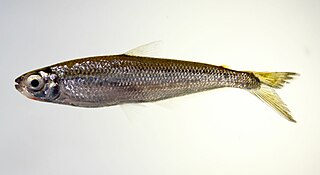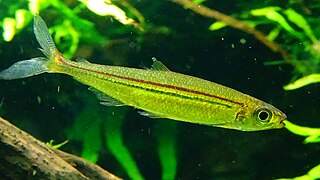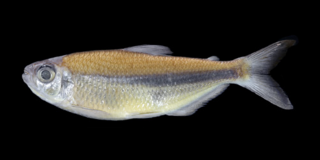
Characidae, the characids or characins, is a family of freshwater subtropical and tropical fish belonging to the order Characiformes. The name "characins" is an historical one, but scientists today tend to prefer "characids" to reflect their status as a, by and large, monophyletic group. To arrive there, this family has undergone much systematic and taxonomic change. Among those fishes remaining in the Characidae currently are the tetras, comprising the very similar genera Hemigrammus and Hyphessobrycon, as well as a few related forms, such as the cave and neon tetras. Fish of this family are important as food in several regions, and also constitute a large percentage of captive freshwater aquarium fish species.

Bryconops is a genus of freshwater fish in the family Iguanodectidae from South America. It consists of small fish, all under half-a-foot long, with slender bodies and silvery scales, though there is some mild color variation. Several species can be identified by way of a humeral patch, and others have a reddish ocellus, or eyespot, on one or both lobes of the dorsal fin.

Iguanodectes is a genus of freshwater fish found in tropical South America, with eight currently described species. They are all small tetras, none longer than 5 inches, and often have attractive silvery or striped scales, which makes them a target for the ornamental fish industry. Alongside the genus Piabucus, it is in the subfamily Iguanodectinae, which in turn is in the family Iguanodectidae. The genus Bryconops, which is also in Iguanodectidae, makes up a sister clade to Iguanodectinae.

Piabucus is a genus of freshwater tetras in the family Iguanodectidae. All three species are found in South America, largely the Amazon and its major tributaries. None of them are longer than half a foot long, with the largest reaching a maximum size of 12.9 cm (5.1 in), and they are slender, with relatively deep chests and long pectoral fins. Their scales are pale or silvery, with lateral lines that stand out.

Iguanodectidae is a family of freshwater fish in the order Characiformes that lives in South America. It is home to the subfamily Iguanodectinae and the monotypic Bryconops clade. Several species in the family, such as the green line lizard tetra, the tailspot tetra, and the orangefin tetra, are sometimes taken as aquarium fish.

Iguanodectinae is a subfamily of small freshwater fish in the family Iguanodectidae. They are most prominently found in the Amazon river basin and its major tributaries, but they are also known from the Tocantins, Orinoco, and Paraguay rivers. It has two genera, Piabucus and Iguanodectes. Some species in the subfamily are taken from the wild for aquariums, like the red- and green-line lizard tetras. There is minor, but ongoing, debate regarding its taxonomy.

Bryconops alburnoides is a small freshwater fish, approximately 6 inches long at its largest, that lives in the rivers of South America. It has a slender body, with a yellowish dorsal fin and yellow-tinged back scales that fade into silver on its belly. It is largely an insectivore that picks land-dwelling insects from the riverbanks, though it eats much more whenever rain washes prey into the water.

The tailspot tetra is a freshwater fish that lives in the coastal river regions of upper South America. Both its common and scientific names reference the distinct spot of color present on the tail fin, which is one of its defining characteristics. It is a small fish, reaching 4.8 in at its longest. Despite its small size, it is an active swimmer, with a preference for fast-flowing waters.

Bryconops colaroja is a small species of fish endemic to tributaries and creeks of the Cuyuni River basin in Venezuela. The specific epithet "colaroja" means "red tailed", and it gets this name from its most distinctive feature - a deep red caudal fin, largely unique amongst members of its genus.
Bryconops durbinae, sometimes listed under the name Bryconops durbini, is a small species of freshwater fish in the family Iguanodectidae. It is the smallest species of the genus Bryconops, and is endemic to the Tapajós river basin in Brazil.

Bryconops piracolina is a small fish that inhabits the waters of Brazil. It is slender and silvery in color, like many fish in Bryconops, but can be distinguished from other members by way of its dorsal fin, which has a black patch of color extending up from the fin-base; congeners usually have light pigment in the dorsal fin, or a brighter color.
Bryconops vibex is a small freshwater fish from the rivers of Venezuela, known solely from the Rio Cataniapo. The body is slender, though with an element of sturdiness, and it has one humeral spot by each pectoral fin. It bears visual similarities to several congeners, but can be differentiated by way of many factors.
Bryconops hexalepis is a small iguanodectid fish from the rivers of Brazil. It is solely found in the drainage of the Rio Tocantins. Rather elongate and quite slender, it is considered one of the smaller species of its genus, with tall scales and large eyes.
Iguanodectes adujai is a species of freshwater fish that inhabits the rivers of South America. It largely prefers slow-moving blackwater habitats, though it has a slender body that suggests a further affinity for flowing water. It has a distinct lateral stripe in two horizontal sections, with bright-red at the top and yellow at the bottom.

Iguanodectes geisleri, the red-line lizard tetra, is a species of freshwater fish from South America. It is a small species, largely herbivorous with some omnivorous traits, that prefers to live in schools and is partial to shallow waters, especially in blackwater habitats. Some aspects of its body plan are unique amongst its genus, including the position and length of the anal fin.
Iguanodectes gracilis is a small species of freshwater fish from South America. It is known solely from the Rio Negro river system, which restricts its range only to Brazil. The name "gracilis" is in reference to a slender body shape, alongside the diminutive nature of I. gracilis - it is the smallest member of the genus Iguanodectes.
Iguanodectes polylepis is a species of freshwater fish from the rivers of South America. Its range is restricted to Brazil, where it inhabits the Madeira and Purus river basins. It is one of the larger members of the genus, but remains generally small, only a little over a quarter-foot long.
Iguanodectes purusii is a small freshwater fish from the rivers of South America. It is largely herbivorous, and prefers to live in schools. The name "purusii" originates from the species' type locality, the Purus river basin of Brazil, with a range that also extends into Peru. Furthermore, it has been documented from the Amazon, Madeira, Guaporé, and Pastaza rivers, but specific study of its ecology is otherwise lacking.
Piabucus caudomaculatus is a small freshwater fish inhabiting the rivers of South America. It was the first member of the family Iguanodectidae to be reported from Bolivia, and it remains endemic to the region, found solely in the Mamoré river basin. It displays a preference for slow-moving waterways and has a largely insectivorous diet.
Piabucus dentatus, also called the chin tetra or the coastal piabucus, is a small freshwater fish from the rivers of South America. It has a wide range that includes multiple coastal drainage systems, and was once mistakenly cited from Peru. Preferred habitats are generally high in silt content and are slow-moving, including floodplain streams and estuaries.








